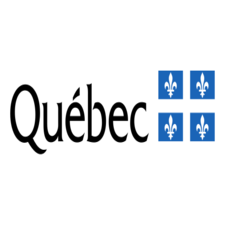north
Type of resources
Topics
Keywords
Contact for the resource
Provided by
Formats
Representation types
Update frequencies
status
-

These digital terrain models (DTM) offer a regional numerical representation of Quebec's relief based on altimetric (altitude) and planimetric (rectangular or geographic) data. They are the result of a collaboration between the Ministry of Natural Resources and Forests (MRNF) and Natural Resources Canada (NRCan) within the framework of the Agreement to produce an up-to-date digital map of northern Quebec and the creation of the product “National Hydro Network (RHN)” for the territory of Quebec. When integrated into a geographic information system, these models allow the implementation of multiple types of spatial analyses such as natural risks, landscape analysis, infrastructure implementation, etc. The MNTs are obtained as a result of hypsometric and hydrographic data processing that uses the concept of hydro-coherence consisting in interpolating altimetric values by ensuring a connected drainage network and an accurate representation of ridges and watercourses. The oriented RHN filament makes it possible to grade lakes and to control the altimeter descent of watercourses. The final product is a quality portrait of relief on a scale of 1/50,000. DNTs provide altitude values that are based on a grid with a resolution of 0.324 arcseconds in geographic coordinates, which corresponds to a resolution of about 10 meters in the field.**This third party metadata element was translated using an automated translation tool (Amazon Translate).**
-

__The link: *Access the data directory* is available in the section*Dataset Description Sheets; Additional Information*__. The mapping of **vegetation in Northern Québec** is a component of an extensive inventory carried out to meet knowledge acquisition needs as part of the economic, social and environmental development project “**Plan Nord**”. This inventory was carried out between **2010 and 2013**. Vegetation mapping in Northern Quebec provides information on terrestrial ecosystems, both forest and non-forest, such as the type of forest cover, undergrowth vegetation, disturbances, etc. A mapping approach based on remote sensing techniques (satellite images) was used. Ground and air control points contribute to the validation and clarification of the information interpreted. This map is available for the entire territory north of the 53rd parallel, which represents an area of approximately 680,000 km2. This territory is presented on topographical bases at a scale of 1/250,000. The minimum mapping area is 16 ha for vegetation and 3 ha for wetlands. **This third party metadata element was translated using an automated translation tool (Amazon Translate).**
-

Deposit is the layer of loose material that covers rock. It may have been established during the retreat of the glacier at the end of the last glaciation or by other processes associated with erosion and sedimentation. The nature of the loose deposit is evaluated based on the shape of the land, its position on the slope, the texture of the soil, or other indicators. Surface deposit maps make it possible to distinguish the main categories of surface deposits, to know their nature, thickness and distribution on Quebec territory. The map of **surface deposits in the North** is a component of an extensive inventory carried out to meet knowledge acquisition needs as part of the economic, social and environmental development project “Plan Nord”. This inventory was carried out between 2010 and 2013. The mapping of surface deposits was carried out using a new approach based on remote sensing techniques. The interpretation was carried out by geomorphologists using RapidEye anaglyph (3D) satellite images with high spatial resolution (5 m). Ground and air control points allowed the validation of the interpreted information. Mapping is available throughout the country north of the 53rd parallel, which represents an area of approximately 680,000 km2. The minimum mapping area is 100 ha. **This third party metadata element was translated using an automated translation tool (Amazon Translate).**
-

__The link: *Access the data directory* is available in the section*Dataset Description Sheets; Additional Information*__. The ecoforest inventory north of the northern limit of attributable forests is an extensive inventory that was carried out for specific knowledge acquisition needs. It was carried out between 2005 and 2009 as part of the work of the scientific committee responsible for examining the northern limit of attributable forests (Nordic Ecoforest Inventory Program [PIEN]). The data in this inventory comes from a cartography that is based both on the use of archival aerial photographs interpreted in three dimensions on the screen and on the analysis of satellite images. This dataset covers the territory between the 50th and 53rd parallel and covers an area of 242,000 km2. It includes forest and ecological mapping data (vegetation, surface deposits and drainage) as well as ecodendrometric sample plot data. This data is distributed by map sheet at a scale of 1/250,000. The minimum mapping area is 8 ha for stands and 4 ha for surface deposits. **This third party metadata element was translated using an automated translation tool (Amazon Translate).**
-

The bank of oblique photographs of Northern Quebec is composed of georeferenced photos taken on board planes or helicopters during flights carried out as part of the program for the acquisition of ecological knowledge in Northern Quebec as part of the economic, social and environmental development project “Plan Nord”. During these overflights, the personnel on board were equipped with high-resolution cameras connected to a satellite geolocation system (GPS). The photos obtained in this way served as control points to improve the various thematic maps. __Note:__ For the purposes of distributing this bank, the photos could be modified slightly in order to improve the shooting. Georeferencing photos on the map refers to the location of the plane or helicopter at the time the shot was taken. **This third party metadata element was translated using an automated translation tool (Amazon Translate).**
 Arctic SDI catalogue
Arctic SDI catalogue